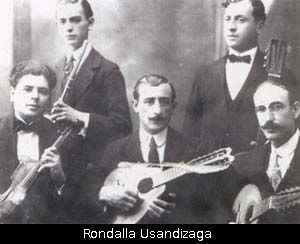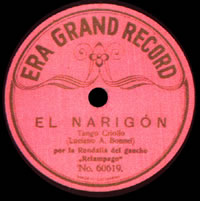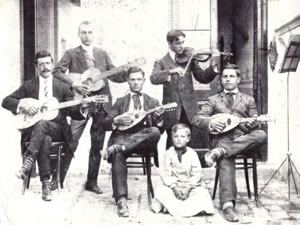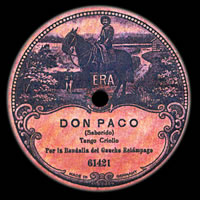By
Bands, rondallas and tangos (Part 2)

aving explained in the first part the features of the rondallas, let’s see now a summary of their discographies.
The first that recorded tangos was the one called Rondalla Vázquez. It made it with a brown Odeon disc label in 1907. Among others: “¿Cómo te va del ojo?” composed by its leader José Vázquez (matrix XBA 141, face 41.503), “El purrete”, by José Luis Roncallo (matrix XBA 149, face 41.507) and “Yunta brava” (matrix XBA 143, face 41.620).

In the early 1910 a generic denomination: Rondalla Gaucho Relámpago entered the scene in the labels Phono D’Art, Era Grand Record and finally plainly Era. Under this heading the most varied instrumental combinations recorded whether as duets, trios or quartets. They were lined up by piano or guitar in the rhythm section and mandolin, accordion, violin or flute may be added in the melodic section.
Some examples are “La perrera” by Juan Castorina (matrix 60.613), “El gringo” by René Lyaz (matrix 60.610) and “¡Devolveme los 20!” by José Felipetti (matrix 60.695).
 It turns out particularly interesting that in different matrix series may be found a predominant (or excluding) composer, such is the case of Juan Carlos Bazán, Genaro Espósito or Vicente Loduca. That happened around 1911 or 1912 and they were duets, trios or quartets with bandoneon, presumably led by the said composers. We have not reached a satisfactory explanation why those bandleaders declined to place the names of their orchestras on the disc labels. We can mention “Don Manchado” by Genaro Espósito in a guitar and bandoneon duo (matrix 60.950), “Sacudime la persiana” by guitar, violin and bandoneón trio (matrix 61.039) and “El Talar”, by a guitar, flute and bandoneon trio (matrix 61.085), with a sound quite similar to the recording of this tango by Vicente Greco on Columbia.
It turns out particularly interesting that in different matrix series may be found a predominant (or excluding) composer, such is the case of Juan Carlos Bazán, Genaro Espósito or Vicente Loduca. That happened around 1911 or 1912 and they were duets, trios or quartets with bandoneon, presumably led by the said composers. We have not reached a satisfactory explanation why those bandleaders declined to place the names of their orchestras on the disc labels. We can mention “Don Manchado” by Genaro Espósito in a guitar and bandoneon duo (matrix 60.950), “Sacudime la persiana” by guitar, violin and bandoneón trio (matrix 61.039) and “El Talar”, by a guitar, flute and bandoneon trio (matrix 61.085), with a sound quite similar to the recording of this tango by Vicente Greco on Columbia.
Also in 1910 a Rondalla Nacional with guitar, flute and mandolin, with a quite elementary way of playing, began its recordings for Odeon, blue label. Let us mention “La capochia” (matrix BG 116, face A 85.114, “El ceibo” by A. Norraca (matrix BG 122, face A 85.120) and “Ferrari” (matrix BG xxx, face A 85.113).

In 1911 the Rondalla Criolla fronted by C. Parisotti recorded for Columbia. It was a polished trio with guitar, flute and mandolin. We can name “La llorona” composed by Carlos Posadas (matrix 55.817, disc T 432), “Rico tipo” by M. Criollito (matrix 55.793, disc T 420) and “Parece mentira” by Martín Quijano (matrix 55.829, disc T 430).
In 1912 for the Atlanta label again recorded the Rondalla Vázquez, the Rondalla Atlanta and also the one led by the Aragón brothers. By the latter we have “Salud, Schenone” composed by Pedro Aragón (face 65.213), “El Piñerista” (face 65.208) and “Cabecita de ajo” written by Justo Morales and Pedro Aragón (face 65.215).
Historically important in this same record company was the Rondalla Criolla Firpo, at that time he was still pianist of Genaro Espósito. It is his debut as bandleader in 1912. We cite “Siga la farra”, piece by Oreste Metetieri (matrix 110, face 65.169), “Sentimiento criollo” composed by Roberto Firpo (matrix 108, face 65.167) and “Galerita” by Eugenio Tulasne (matrix 111, face 65.170).
 Then in 1912 and 1913 the Rondalla Criolla recorded for the Homokord label. Also in this case it is a generic denomination for varied combinations of different instruments, basically guitar, flute, violin, accordion and mandolin. We highlight “El tirano”, a number by David Grasso (matrix 70.356), “Decime que sí” by Ezio Dall’Ovo (matrix 70.531) and “Sarita” by Carlos Hernani Macchi (matrix 70.384).
Then in 1912 and 1913 the Rondalla Criolla recorded for the Homokord label. Also in this case it is a generic denomination for varied combinations of different instruments, basically guitar, flute, violin, accordion and mandolin. We highlight “El tirano”, a number by David Grasso (matrix 70.356), “Decime que sí” by Ezio Dall’Ovo (matrix 70.531) and “Sarita” by Carlos Hernani Macchi (matrix 70.384).
We close this evocation of the main aggregations, with the recordings that during 1913 the correct Rondalla Criolla Fígaro, lined up by guitars, mandolin and maybe a lute, cut for Odeon. His tangos, among others, were “Gran Hotel Victoria (Hotel Victoria)” (matrix BA 004, face A 86.037), “Emancipación” by Alfredo Bevilacqua (matrix BA 022, face A 86.038) and “Rodríguez Peña” (matrix BA 033, face A 86.039).